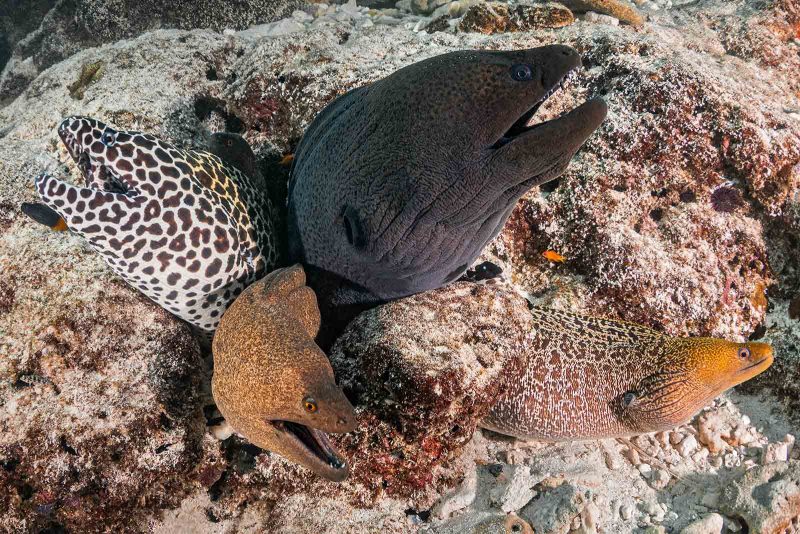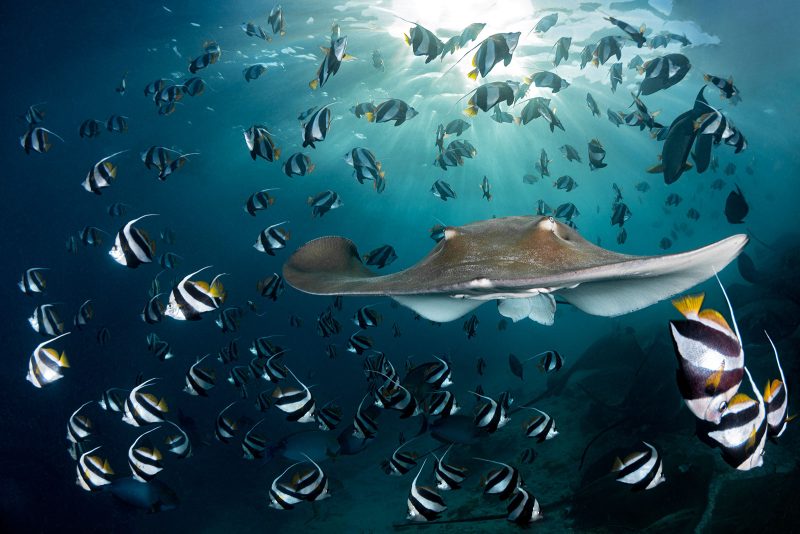Capturing an Award-Winning Underwater Photograph

The Maldives are one of the world’s most visited diving destinations, well known for warm, tropical waters and an abundance of marine life. This is where I photographed my award-winning underwater photograph ‘Sunset Ray’.
Over the years I have visited the Maldives several times. Each time I’ve witnessed how various coral bleaching events, caused by a sudden rise in water temperature due to global warming, have affected the condition of the underwater world.


Where healthy, colourful, and vibrant reefs used to thrive, there is often nothing left other than vast areas of dead coral, covered in slimy algae. Corals build the foundation of reefs and – as has been proven in other areas around the world – can adapt to changing water temperatures.

However, they need time for that; time they haven’t had in the past 20 odd years. Luckily, not all the corals in the Maldives have been affected by these bleaching events and signs of recovery can be found.
Storytelling through photography
With my photography, I am trying to show how beautiful the underwater world is on the one hand, and how fragile it is on the other. My goal is to create awareness of what is at stake if humanity keeps treating our planet the way we have been.
For this, I try to show beauty rather than destruction and desperation, just as in the winning photo that I named ‘Sunset Ray’. I am convinced that beautiful nature photography inspires individuals to make better, more sustainable choices in their lives, and to become aware of the impacts what they consume has on our environment.
Also, photos of endangered species create an emotional connection and raise awareness of the threats they face. Generally, nature photography generates demand for nature-based activities and tourism, which helps finance and develop environmental and wildlife protection programs.

Not far away from Malé, the Maldives’ capital and main island, there is a small island called Kanduoih-giri with nothing else on it but a factory that processes tuna for export.
The Maldives are known for sustainably catching tuna without nets, catching one fish at a time without targeting other species and never catching entire schools.

What happens at this factory, and this has been happening for years, is that after they are done processing the fish, they dump the remains into the ocean. It’s mainly bones, heads, and skin, but for anything that lives in the sea and eats fish, it is food.

This explains why there are large numbers of various fish species always patrolling the area. Including a huge school of bannerfish, large pink whiprays, and even larger round ribbontail rays. As well as various moray eel species, such as honeycomb and giant moray eels to name a few.
Taking an award-winning photograph
I shot ‘Sunset Ray’ on my first ever visit to this dive site. I had heard many good things about it and seen some wonderful shots taken here, so I knew what to expect. This site is also known for guitar rays and big sharks such as bull or tiger sharks that are regularly seen in the deeper area of the site.
As it was the last dive of a live-aboard trip before I flew out early the next day, I knew I had to stay shallow and couldn’t dive down to the deeper area with the rest of the group to look for bigger fish. So, while everybody else went deep, I stayed up in the shallows, not diving deeper than 6 metres, and played around with what the site had to offer in the top few metres.
I love shooting against the sun because it creates those beautiful sunbursts in the water, especially when the sun is getting low. I dove around for a few minutes until I found a great spot where I could shoot against the setting sun. Framing the schooling bannerfish and the pink whiprays that were constantly circling the area; I took plenty of shots and tried different settings and positions.

The fact that I was the only diver in the area made conditions perfect for photography. No humans, no bubbles, and no photo bombers.
Diving all by yourself is normally not allowed for safety and insurance reasons just in case something happens. However, there are courses on how to become a solo or self-reliant diver which make diving alone safe and legally OK.
For photographers, diving alone can be a game changer. I highly recommend taking one of these courses; unless you have a buddy that is willing to always stay close to you without getting into your shots.
Shooting against the sun
Shooting underwater, against the sun, is similar to shooting against the sun on land. If you don’t mix in some artificial light, you will lose a lot of colour and detail in the foreground.
That’s why it is common practice in underwater photography to use powerful, external strobes that are attached to the camera housing with flexible arms. This is exactly how I work whenever I shoot under the surface.
To have balanced light I use dual strobes. For wide-angle photography (as in all the photos in this article) I usually position the strobes as far out as possible to the left and right of the camera. Keeping them on the same level as the lens and behind it, but slightly angled out, reduces the overlap of the light beams, which reduces the amount of backscatter in the photos.
The light coming from underwater strobes usually doesn’t travel any further than 2-3 metres which is why only close subjects are lit up. Just as in this picture from the same dive but right before the end; the sun was even lower, creating these greenish-yellow tones.

The ray in the above photo has been through a lot. If you look closely, you can see it has a fishing hook and some fishing line on the lower side. Also, its snout is completely split but has healed up, most probably also from a fishing incident. I felt very sorry for this animal.
Due to the limited visibility in general and the short distance artificial light can travel underwater, being able to get close to subjects is key in underwater photography. To be able to do so it is necessary to be a skilled diver.
Key skills for underwater photography
To anybody that wants to get into underwater photography, I always recommend first becoming a skilled diver before touching a camera. Being able to fully control where you’re going, keeping still in one place mid-water, and holding your breath for some time are just some of the skills you’ll need to get close to underwater wildlife.
At the same, time make sure you don’t harm yourself or the underwater world around you, e.g., breaking corals with your fins.
The other important factor is to understand the behaviour of the subject you want to capture. This allows you to adjust accordingly and anticipate where it is going and how to position yourself to get a good shot. The better you get at these key skills, the better you are set up to get good photos, besides knowing how to handle your camera gear of course!
In conclusion
I hope these insights will help you to create some inspiring photographs of our beautiful underwater world and I am already looking forward to next year’s competition.
Of course, I will try my luck again!






